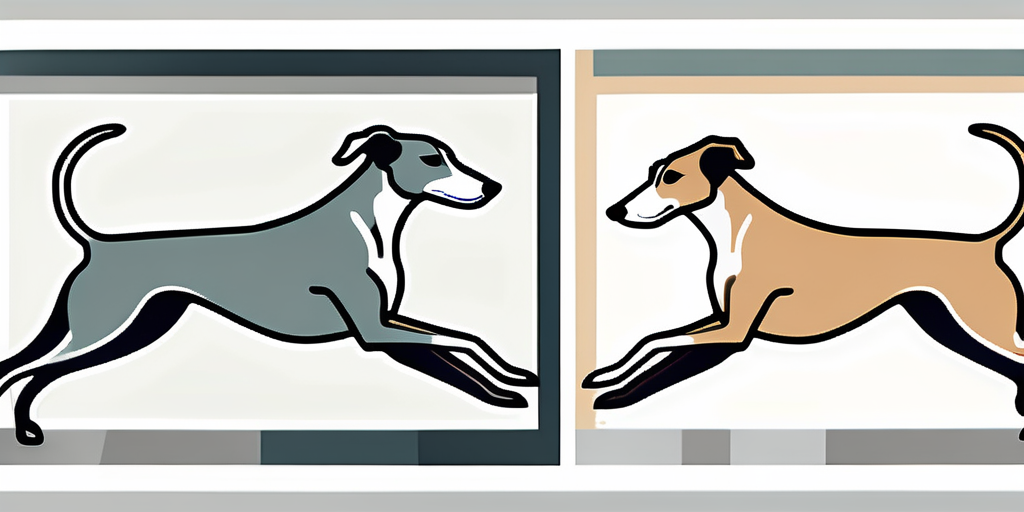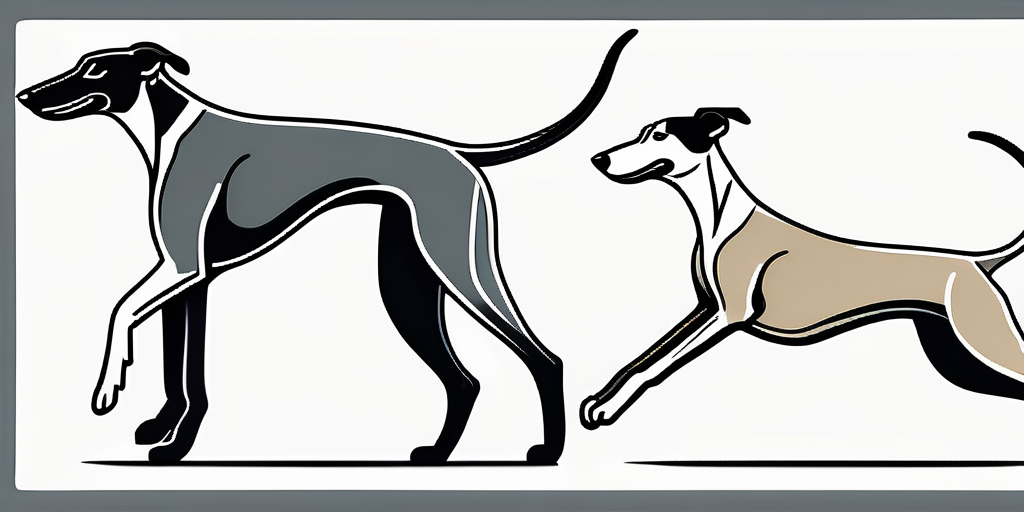The Greyhound and the Whippet are two popular dog breeds that are often compared due to their similarities in appearance and purpose. While both breeds share a common ancestry, they also have distinct characteristics that set them apart. In this article, we will delve into the basics of these breeds, explore their physical traits, discuss their temperaments, touch on their health and lifespan, and outline their training and exercise needs.
Understanding the Basics: Greyhound and Whippet
Origin and History of Greyhounds
The Greyhound breed has a rich and ancient history that dates back to ancient Egypt. These elegant dogs were highly prized by the nobility and were often associated with royalty. Over the centuries, they were bred for their exceptional speed and agility, making them perfect for coursing and hunting. Today, Greyhounds are primarily known for their prowess on the racetrack.

Greyhounds are known for their unique physical characteristics, such as their slender build, deep chest, and long legs. These features contribute to their incredible speed and endurance, allowing them to reach impressive speeds of up to 45 miles per hour in just a few strides. Despite their athletic abilities, Greyhounds are also beloved for their gentle and affectionate nature, often referred to as “couch potatoes” due to their love of lounging and relaxing indoors.
Origin and History of Whippets
Whippets, on the other hand, have a more recent history compared to Greyhounds. They were developed in England during the 19th century by crossing small Greyhounds with various terrier breeds. This selective breeding produced a smaller and more manageable dog that could still showcase impressive speed and athleticism. Whippets were originally bred for hunting small game like rabbits, but they soon caught the eye of dog enthusiasts for their charm and companionship.
Whippets are often described as “miniature Greyhounds” due to their similar appearance and graceful movements. Despite their smaller size, Whippets share the Greyhound’s love for running and have been nicknamed “the poor man’s racehorse” for their ability to sprint with agility and grace. In addition to their athletic abilities, Whippets are known for their friendly and sociable personalities, making them excellent family pets and loyal companions.
Physical Characteristics: A Side by Side Comparison
Size and Weight Differences
One of the most noticeable differences between Greyhounds and Whippets is their size. Greyhounds are larger, typically standing at 28 to 30 inches at the shoulder and weighing between 60 and 70 pounds. In contrast, Whippets are smaller, measuring around 18 to 22 inches at the shoulder and weighing between 25 and 40 pounds. Despite their size disparity, both breeds possess a sleek and muscular build that enables them to reach remarkable speeds.
Greyhounds, known for their elegant stature and long legs, are often referred to as the “40-mile-per-hour couch potato” due to their incredible sprinting abilities followed by long napping sessions. On the other hand, Whippets, sometimes called “the poor man’s racehorse,” are smaller in size but share the Greyhound’s love for speed and agility. Their compact build allows them to excel in various canine sports such as lure coursing and agility trials.
Coat and Color Variations
Both Greyhounds and Whippets have short, smooth coats that require minimal grooming. However, notable differences can be found in their coat textures and color variations. Greyhounds have a coarser coat with a variety of solid colors or patterns. They can be seen sporting black, brindle, fawn, or white coats, among others. Whippets, on the other hand, have a softer and finer coat often seen in solid colors such as black, brindle, blue, fawn, or white.
When it comes to coat care, Greyhounds are known to have a unique skin that is sensitive and prone to irritation, requiring gentle grooming practices and regular checks for any signs of discomfort. In contrast, Whippets have a more resilient skin that is less prone to issues, making them a bit easier to maintain in terms of grooming. Both breeds, however, benefit from regular baths and brushing to keep their coats healthy and shiny, showcasing their natural beauty and elegance.
Temperament and Personality Traits
Greyhound Temperament
Greyhounds are known for their gentle and laid-back nature. Despite their reputation as racing dogs, they are often described as couch potatoes once they retire. Greyhounds are typically calm, easygoing, and highly sociable. They adore spending time with their human companions and may exhibit an inherent affinity for children. As sight hounds, they do possess a strong prey drive, so caution should be exercised in off-leash areas or around smaller pets.
One fascinating aspect of Greyhound temperament is their sensitivity to their environment. These dogs are known to be very attuned to the emotions of their owners, often providing comfort and support during times of distress. Their empathetic nature makes them excellent therapy dogs, bringing joy and solace to those in need. Additionally, Greyhounds are renowned for their graceful demeanor and elegant presence, characteristics that have made them popular subjects in art and literature throughout history.
Whippet Temperament
Whippets share many personality traits with Greyhounds, including their affectionate and loving nature. They thrive on human companionship and enjoy being part of a family. Whippets are generally more agile and playful than their larger counterparts, often engaging in bursts of energy and displaying their remarkable speed. Despite their active nature, they also appreciate their downtime and are content to relax on a cozy spot with their owners.
One interesting aspect of Whippet temperament is their strong sense of independence. While they are devoted to their families, Whippets also have a streak of self-reliance that sets them apart. This independence can manifest in their decision-making, as they are known to have a mind of their own when it comes to certain situations. Whippets are also recognized for their keen intelligence and problem-solving abilities, making them quick learners in various training activities. Their combination of athleticism and intelligence makes them versatile companions for a variety of lifestyles.
Health and Lifespan: What to Expect
Common Health Issues in Greyhounds
Like all dog breeds, Greyhounds are susceptible to certain health issues. Common conditions seen in Greyhounds include bloat, which is a life-threatening condition characterized by a twisted stomach. They are also prone to osteosarcoma, a type of bone cancer, and dental issues. It is crucial for Greyhound owners to provide regular veterinary care and keep a close eye on their dog’s overall health.
Greyhounds are known for their athleticism and speed, which can sometimes lead to injuries such as muscle strains or ligament tears. Proper warm-up exercises and cool-down routines can help prevent these issues in Greyhounds, ensuring they stay healthy and active for longer periods.
Common Health Issues in Whippets
Whippets, too, have their share of health concerns. While they are generally considered a healthy breed, they may be prone to certain conditions. Hypothyroidism and cardiac abnormalities are occasionally seen in Whippets. Additionally, they are sensitive to extreme weather conditions due to their thin coat, so extra precautions should be taken to protect them from the cold or excessive heat.
Whippets are known for their gentle and affectionate nature, making them great companions for families. However, their sensitive skin requires special attention, as they can be prone to skin irritations or allergies. Regular grooming and using gentle, hypoallergenic shampoos can help maintain the health and comfort of Whippets’ skin and coat.
Training and Exercise Needs
Training a Greyhound: Tips and Techniques
Due to their independent nature, training a Greyhound can have its challenges. However, with patience, positive reinforcement, and consistency, these sensitive dogs can become well-mannered and obedient companions. Greyhounds respond well to reward-based training methods and benefit from early socialization to ensure they are comfortable in various situations.

Greyhounds are known for their incredible speed and agility, stemming from their history as racing dogs. Incorporating activities that allow them to stretch their legs and run freely can help fulfill their exercise needs. Consider taking your Greyhound to a secure, fenced area where they can sprint and play to their heart’s content.
Training a Whippet: Tips and Techniques
Whippets, being intelligent and eager to please, are generally easier to train compared to Greyhounds. They are highly food-motivated, making positive reinforcement training an effective approach. Whippets thrive on mental stimulation, so incorporating interactive toys or puzzles into their training sessions can also help keep them engaged and focused.
Similar to Greyhounds, Whippets also have a history rooted in racing. Their slender build and powerful muscles make them capable of impressive bursts of speed. Providing opportunities for your Whippet to participate in lure coursing or agility training can help them channel their energy in a positive and fulfilling way.
Ultimately, whether you choose a Greyhound or a Whippet as your canine companion, both breeds have their own unique qualities that make them cherished pets. By understanding their history, physical traits, temperament, health concerns, and training needs, you can make an informed decision as to which breed aligns best with your lifestyle and preferences.
Discover More with BreedRead’s Expert Insights
Choosing between a Greyhound and a Whippet is just the beginning of your journey with your new companion. At BreedRead.com, we provide a wealth of knowledge to support you every step of the way. From in-depth breed comparisons to tailored care guides, our free online resource is designed to help you make informed decisions and provide the best care for your dog. Subscribe to our free newsletter today and gain access to expert insights that will help you and your furry friend enjoy a healthier, happier life together.

